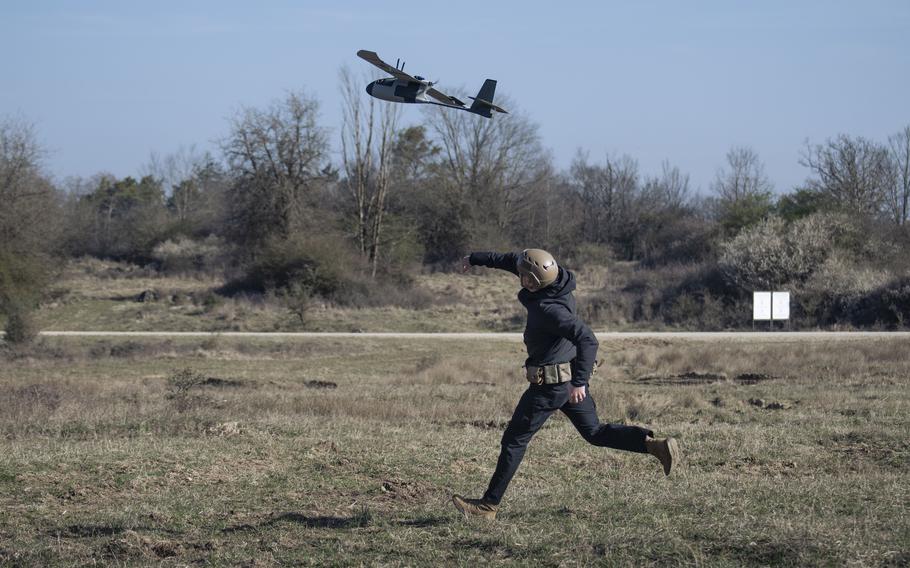
Army Chief Warrant Officer 2 Chris Lehr hand-launches a homemade 3D printed fixed-wing drone at the Joint Multinational Readiness Center in Hohenfels, Germany, April 11, 2025. The initial three test flights were unsuccessful, but subsequent design adjustments resulted in a controlled flight several days later. (Lydia Gordon/Stars and Stripes)
HOHENFELS, Germany — Chief Warrant Officer 2 Chris Lehr and his small team of Wiesbaden-based soldiers spent about a year working on homemade, 3D-printed drones they weren’t sure would work.
Last week, members of the 2nd Multi-Domain Task Force finally had the opportunity to find out if their creation could get off the ground with an initial round of testing at the Army’s Joint Multinational Readiness Center in Hohenfels.
“This thing could crash and burn,” Lehr said April 11, as a five-day electronic warfare exercise dubbed Spectrum Blitz happened to be going on around them. “Luckily, we’ve got the airspace to test this out in.”
Equipped with cautious optimism and a box of drone components team members had produced themselves, the group made three unsuccessful tries during the exercise.
But after returning to Wiesbaden to make some modifications, Lehr and his group followed up the flop with a much more successful test run Thursday, with the drone maintaining controlled flight.
The difference-maker, as it turned out, was a switch to a tilt-rotor platform rather than a fixed-wing design.
“We added two more motors and a tilt function so that it takes off (vertically),” Lehr said Thursday. “We thought the hand-launched variant would be easier, and it was not.”
That has the team feeling confident about fielding the drones at Arcane Thunder, an exercise in May in Poland.
The task force’s high-tech tinkering is the latest example of how small units across the Army are looking for an edge on a future battlefield where drones are expected to play a decisive role.
As the development lead at the Innovation Lab, Lehr helps develop training aides and environments for soldiers.
The 2nd Multi-Domain Task Force has been in existence since 2021, with the unit’s Innovation Lab officially opening in May of last year.
Its work is an example of a concept the Army calls Transforming in Contact, an effort across the service to adapt the way soldiers fight to the new realities on the battlefield.
Task force members treated the setbacks in Hohenfels as an opportunity to learn lessons from failure.
“I feel like the Wright brothers,” said Sgt. 1st Class Matthew Pope, the battalion’s electromagnetic warfare master trainer, as Lehr proceeded with systems checks on the first of three test drones scheduled for the April 11 experiment. The first test ended with the drone nosediving seconds after the hand launch, despite near-perfect weather conditions.
Only the filament frame was damaged, Lehr said. All internal components could be salvaged and installed into a new frame.
And by using homemade drones, the team could give it another shot much more quickly and cheaply than would have been the case with the crash of a commercially produced model.
Although the next two flights also ended in crashes, team members came away from Hohenfels with confidence in their thinking that they knew what the problem was.
On the heels of their successful modification, now the team’s challenge is building enough spare parts in time for Arcane Thunder.
“I’m very confident we’re going to use this drone in Poland,” Lehr said. “I think moving forward we’re going to look at larger platforms and stick with the vertical takeoff and landing.”